
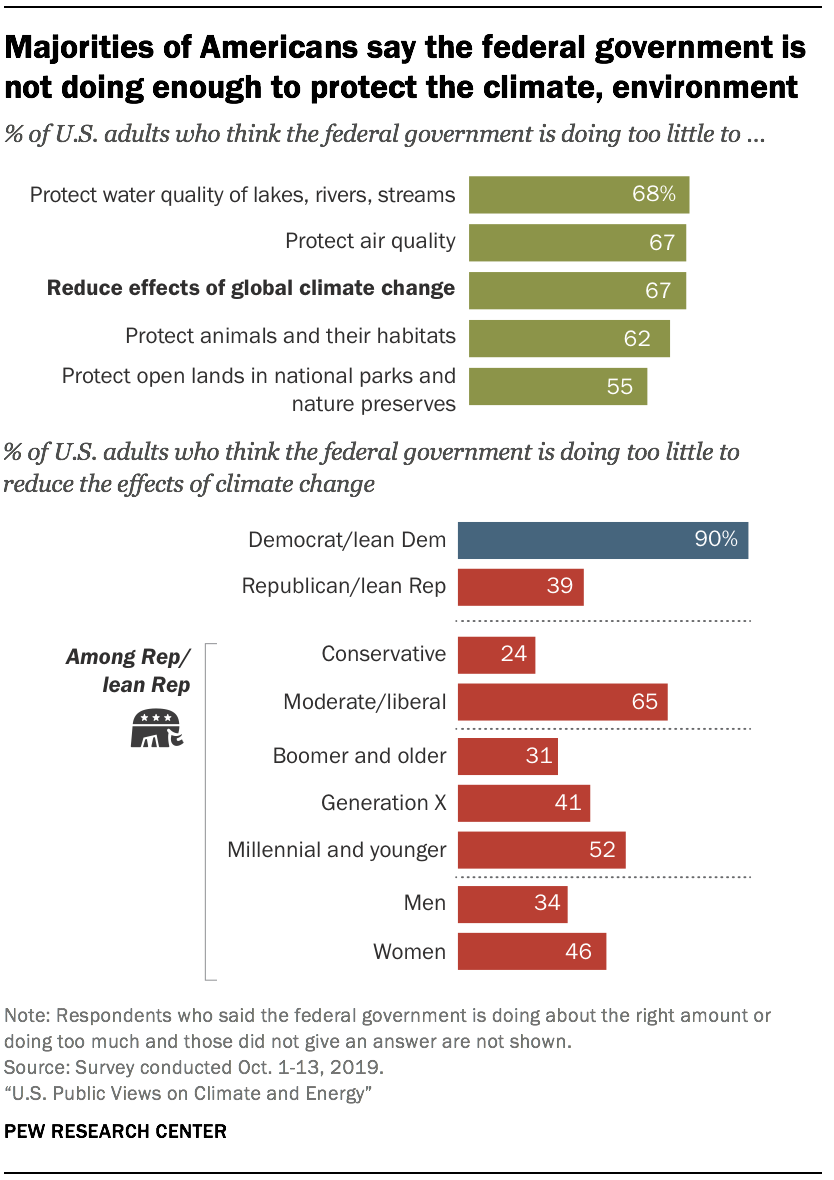
Majorities of Americans say the federal government is doing too little for key aspects of the environment, from protecting water or air quality to reducing the effects of climate change. And most believe the United States should focus on developing alternative sources of energy over expansion of fossil fuel sources, according to a new Pew Research Center survey.
A majority of U.S. adults say they are taking at least some specific action in their daily lives to protect the environment, though Democrats and Republicans remain at ideological odds over the causes of climate change and the effects of policies to address it, according to the survey of 3,627 U.S. adults conducted Oct. 1 to Oct. 13, 2019, using the Center’s American Trends Panel.
These findings come amid the Trump administration’s intention to officially withdraw from the 2016 Paris climate accord and ongoing efforts to roll back domestic environmental protection regulations, including relaxing limits on methane and carbon emissions.
About two-thirds of U.S. adults (67%) say the federal government is doing too little to reduce the effects of climate change, and similar shares say the same about government efforts to protect air (67%) and water quality (68%) – findings that are consistent with results from a 2018 Center survey.
While there is strong consensus among Democrats (90%, including independents who lean to the Democratic Party) on the need for more government efforts to reduce the effects of climate change, Republican views are divided along ideological, generational and gender lines. A majority of moderate or liberal Republicans (65%, including GOP-leaning independents) say the federal government is doing too little to reduce the effects of climate change. In contrast, only about one-quarter of conservative Republicans (24%) say the same, while about half (48%) think the government is doing about the right amount and another 26% say it is doing too much.
There are also divides by age. Among younger Republicans – adults in the Millennial generation and Generation Z, ages 18 to 38 in 2019 – 52% think the government is doing too little on climate. By comparison, 41% among Generation X and 31% of Baby Boomer and older Americans say this. Republican women (46%) also are more inclined than GOP men (34%) to think the government’s efforts on climate are insufficient.
Views about government efforts to protect the environment in areas such as water or air quality show similar differences among Republicans by ideology, generation and gender.
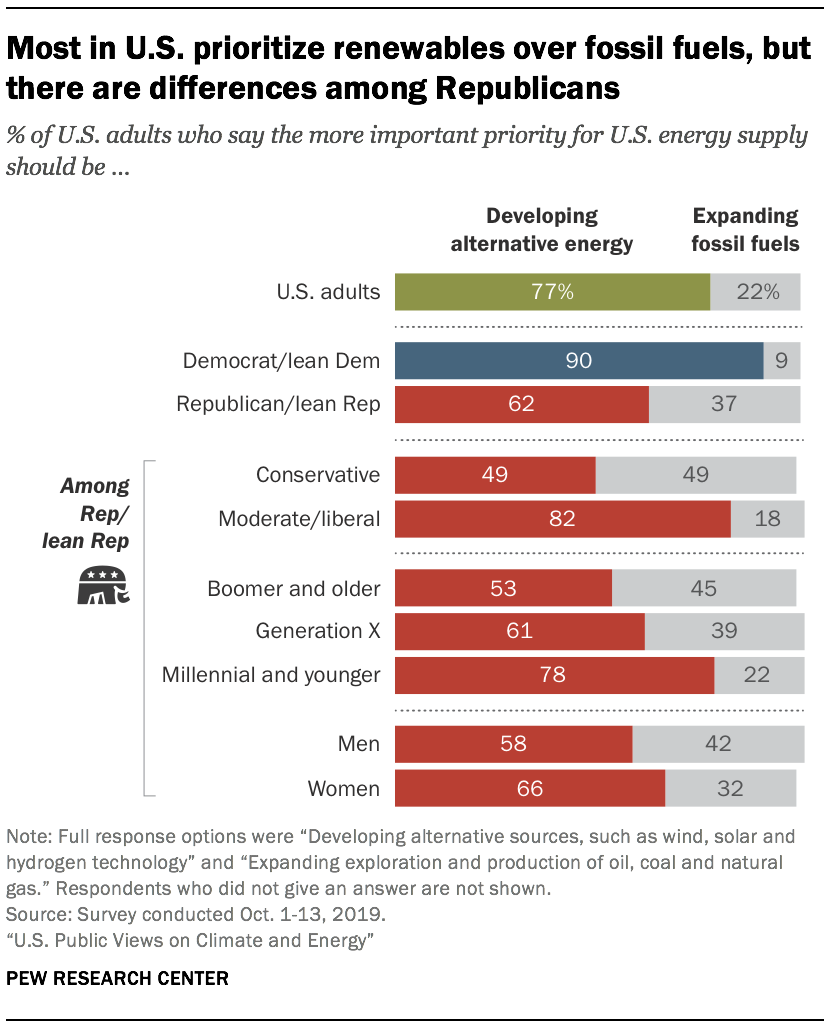
Overall, about three-quarters of Americans (77%) agree that the more important energy priority should be developing alternative energy sources such as wind and solar power and hydrogen technology rather than increasing U.S. production of fossil fuels.
The vast majority of Democrats (90%) believe the U.S. should prioritize alternative energy development over expanded oil, coal and natural gas exploration and production. While generally supportive of prioritizing alternative energy sources, Republicans differ by ideology and generation, and more modestly by gender, in their views of U.S. energy supply priorities.
Most moderate or liberal Republicans (82%) say the U.S. should prioritize alternative energy sources. But conservative Republicans, who represent the party majority, are evenly divided over whether to prioritize alternative energy (49%) or expand fossil fuel production (49%). (Roughly two-thirds of Republicans and Republican leaners – 65% – describe themselves as conservative, while 34% are moderate or liberal, according to an average across four Center surveys conducted this year.)
In addition, a strong majority of younger Republicans (78% of Millennial and Gen Z adults, i.e., those ages 18 to 38) say the U.S. should prioritize alternative energies, compared with 61% of Gen X Republicans and about half of Baby Boomer and older Republicans (53%). GOP women tend to prioritize alternative energy development over expanding fossil fuels (66% to 32%). A smaller share of Republican men prioritize alternative energy development (58%) over fossil fuel expansion (42%).
Compared with 2017, support for prioritizing alternative energy development appears to be up among both Democrats and Republicans. However, in the 2017 survey, which was conducted by telephone, 5% of the public volunteered that both alternative energy and fossil fuels should be equal priorities. These methodological differences could account for the differences in findings over time. (See the Appendix for details).
How Americans view the impact of climate change depends on where they live
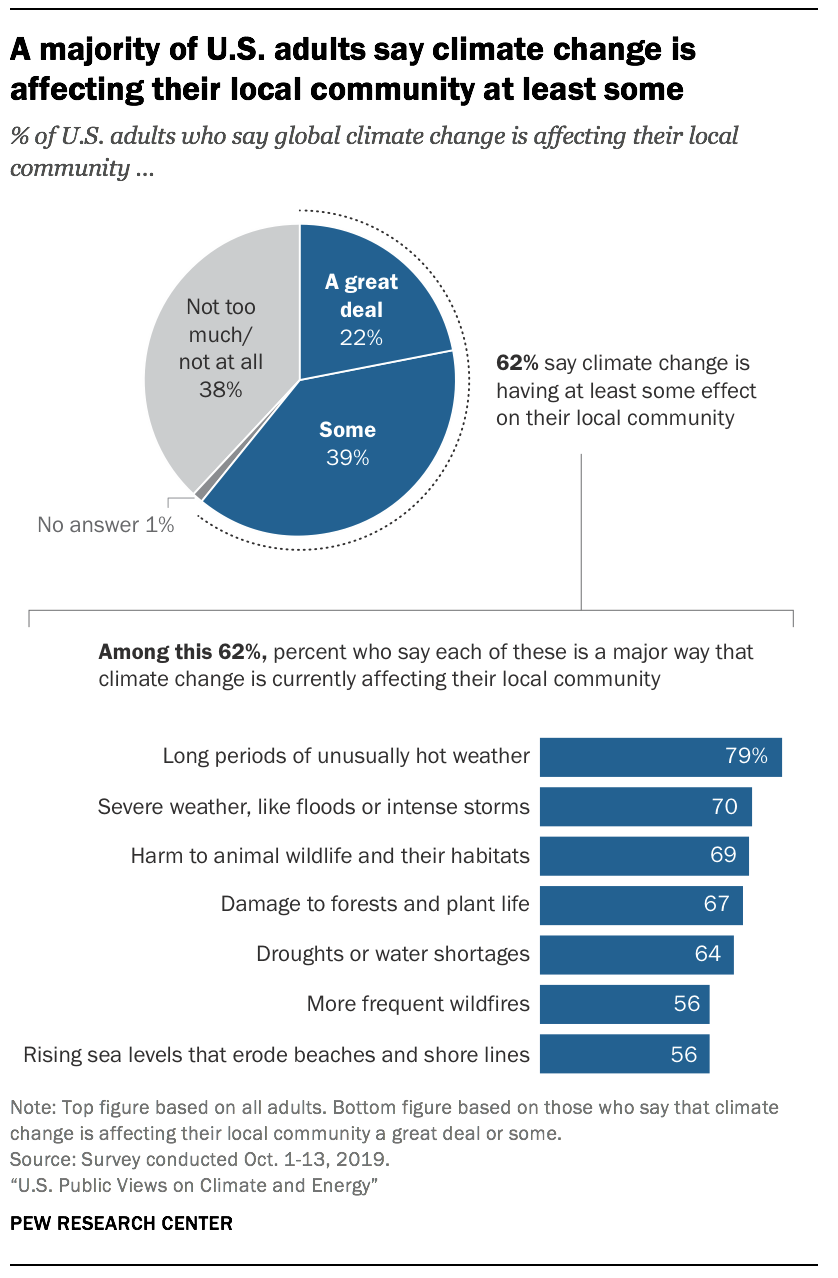
Most Americans today (62%) say that climate change is affecting their local community either a great deal or some. That figure remains fairly steady from last year, when 59% reported at least some local effects of climate change.
The vast majority of this group says long periods of unusually hot weather (79% of those asked or 49% of all U.S. adults) represent a major local impact of climate change. They also say major effects include severe weather such as floods and intense storms (70%), harm to animal wildlife and their habitats (69%), damage to forests and plant life (67%) or droughts and water shortages (64%). More frequent wildfires and rising sea levels that erode beaches and shorelines also are cited by equal percentages (56% of those asked) as major impacts to their local communities.
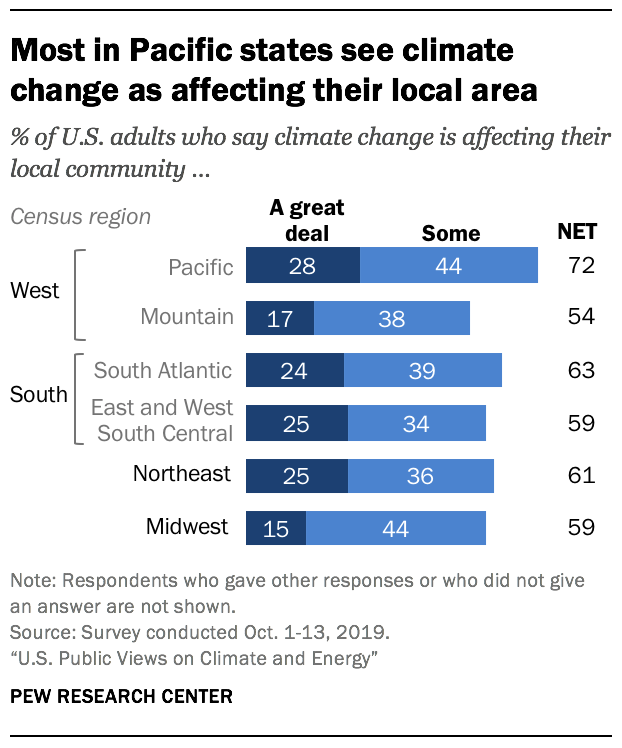
The degree to which Americans report experiencing effects of climate change in their local community varies by geographic region. Americans in Pacific states (which include California, Washington, Oregon, Hawaii and Alaska) are most likely to see at least some local impacts of climate change (72%). By comparison, 54% of those living in Mountain states (Arizona, Colorado, Nevada, Utah, New Mexico, Idaho, Montana and Wyoming) say climate change is affecting their local area at least some.
Large shares of Americans nationwide who report at least some local impact of climate change cite long periods of unusually hot weather as occurring where they live. Other major effects of climate change, however, tend to vary by region.
Those living in Western states stand out as particularly likely to report increasing frequency of wildfires or droughts/water shortages as local effects of climate change. For example, those who see climate effects locally in Pacific and Mountain states say more frequent wildfires are a major effect of climate change in their area (83% and 78%, respectively), compared with 52% of those in the South, 46% in the Northeast and 40% in the Midwest who say the same.
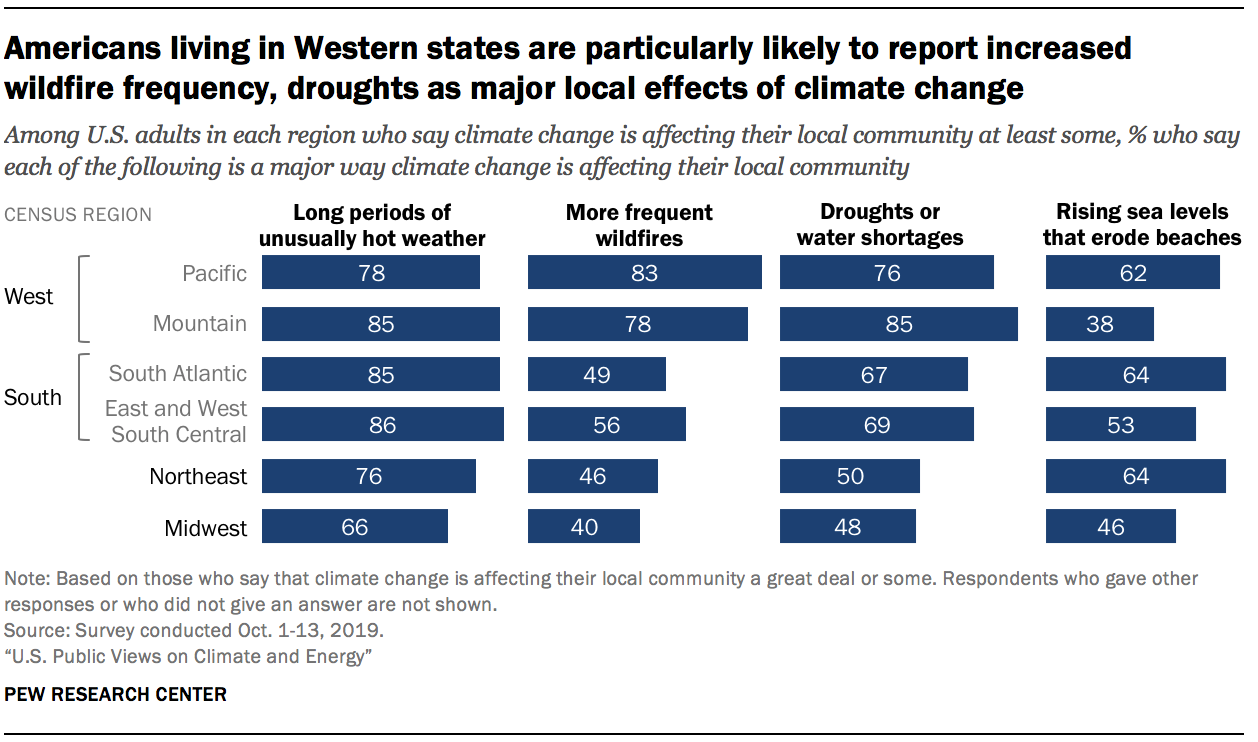
Proximity to coastline also makes a difference, the survey shows. Respondents living within 25 miles of a coastline anywhere in the U.S. are modestly more inclined to say that climate change is having at least some effect in their community; 67% of this group says this, compared with 60% of those living between 25 and 300 miles inland and 59% of those living 300 miles inland or more.
About seven-in-ten (72%) of those who live within 25 miles of a coastline nationwide – and who also report at least some local climate change effects – cite rising sea levels as a major impact. That experience is reported by fewer than half (45%) of those who live at least 300 miles inland and see at least some local effects of climate change.
A partisan lens also plays a role in these perceptions. Democrats and Democratic leaners (82%) are more likely than Republicans (38%, including leaners) to report at least some effects of climate change on their local communities.1
Political groups remain divided over climate change causes and policies
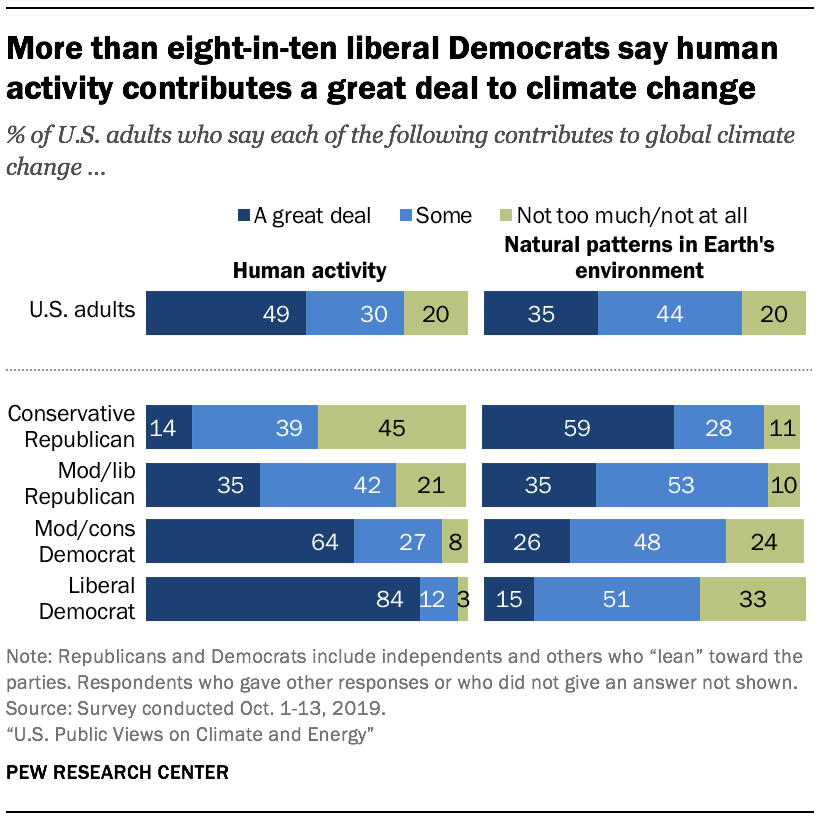
Overall, about half of Americans (49%) say human activity contributes a great deal to climate change, and another 30% say human actions have some role in climate change. Two-in-ten (20%) believe human activity plays not too much or no role at all in climate change.
Survey respondents also were asked to rate the degree to which they believe natural patterns (such as regular warming and cooling cycles) contribute to climate change.
Roughly a third of adults (35%) say natural patterns in the Earth’s environment contribute a great deal to climate change, and another 44% say natural patterns contribute to some extent.
[callout align=”alignright”]
How surveys ask about climate change matters
Of the two-in-ten who think human activity has little or no role in climate change, most say that natural patterns contribute to climate change either a great deal or some. Just 4% of Americans say that neither human activity nor natural patterns contribute to global climate change at least some.
The findings underscore the degree to which Americans remain divided along party and ideological lines when it comes to their beliefs about the causes of climate change.
A strong majority of liberal Democrats (84%) say human activity contributes a great deal to climate change, with near consensus among them that human activity contributes at least some amount to climate change (96%). In contrast, about half of conservative Republicans (53%) say human activity contributes a great deal (14%) or some (39%) to climate change. Another 45% of this group says humans play not too much or no role in climate change.
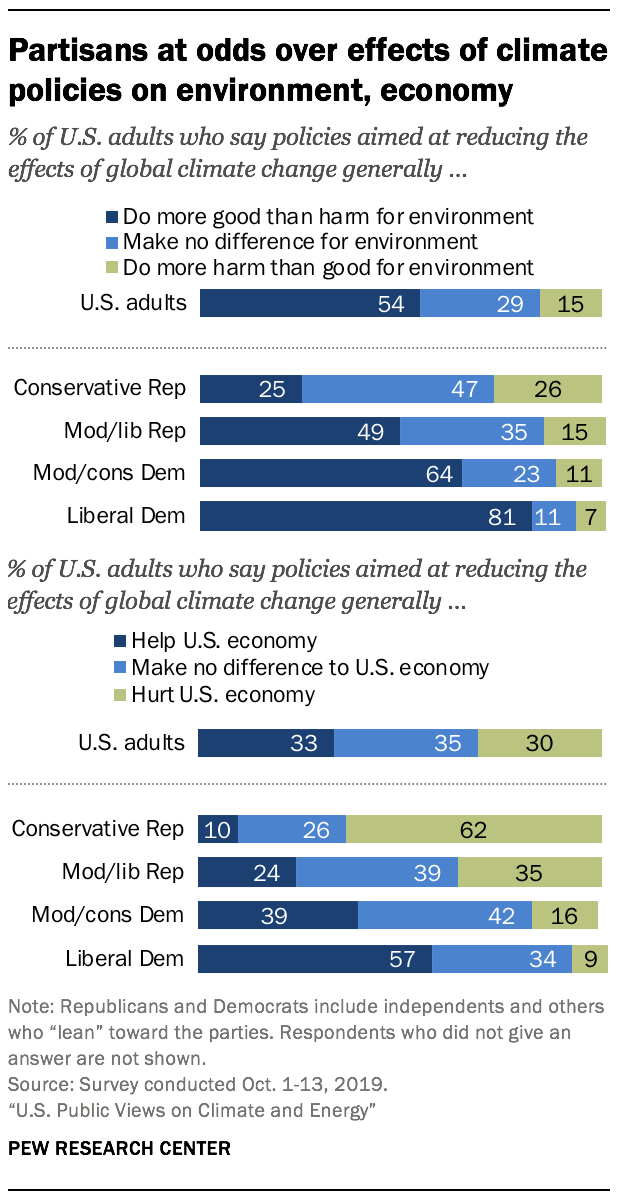
Republicans and Democrats in the ideological middle within their respective parties (that is, moderate/liberal Republicans and moderate/conservative Democrats) fall somewhere in between in terms of how they see human activity influencing climate change. For instance, 35% of moderate or liberal Republicans say human activity has a great deal of impact on climate change, while roughly two-thirds of moderate or conservative Democrats (64%) see it as a major contributor.
Partisan divisions remain when it comes to how Americans perceive the effects of climate change policies on the environment and the economy. (These core differences also were evident in a 2018 Center survey.)
An overwhelming majority of liberal Democrats (81%) say climate policies result in net benefits for the environment, while just 7% say such policies do more harm than good and 11% think they have no effect on the environment. Also, most liberal Democrats (90%) think climate policies either help or have no effect on the economy.
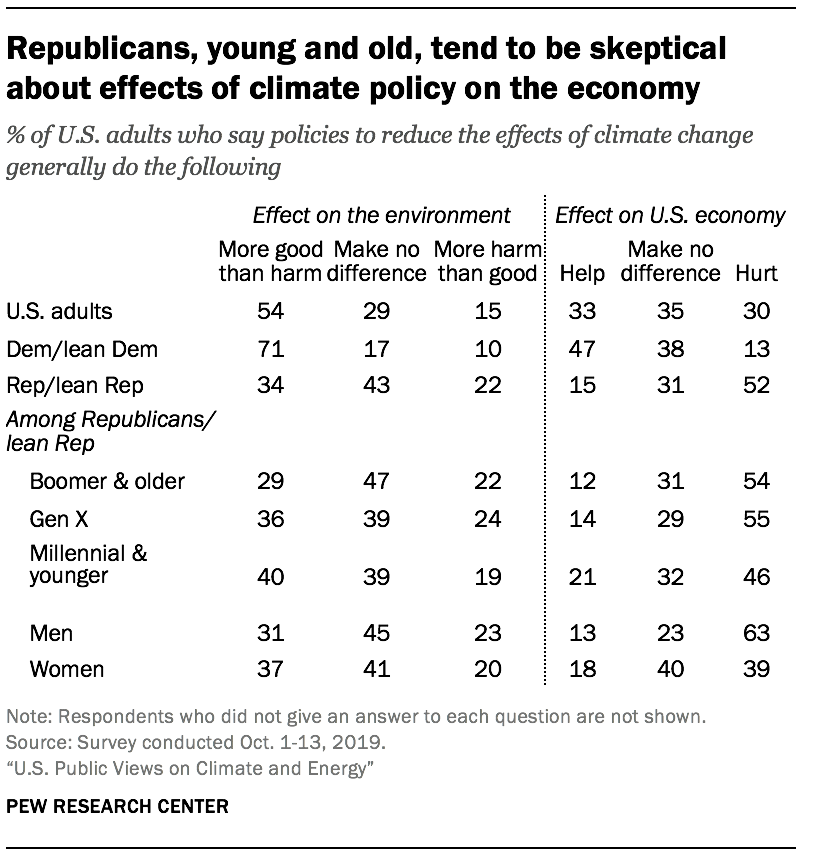
Conservative Republicans stand out as particularly skeptical about the benefits of climate policies for the environment. A minority of this group (25%) says such policies do more good than harm for the environment, and a majority (62%) says these policies hurt the economy.
A greater percentage of Millennial and Gen Z Republicans (40%) than those who are Baby Boomers and older (29%) view climate policies as doing more good than harm for the environment, but sizable shares in both generations believe such policies hurt the economy.
Republican men (23%), meanwhile, are about as likely as GOP women (20%) to think that climate policies bring net harm to the environment but are significantly more likely than GOP women (63% vs. 39%) to say that such policies hurt the economy.
Two-thirds of Americans say using fewer single-use plastics makes a big difference for the environment
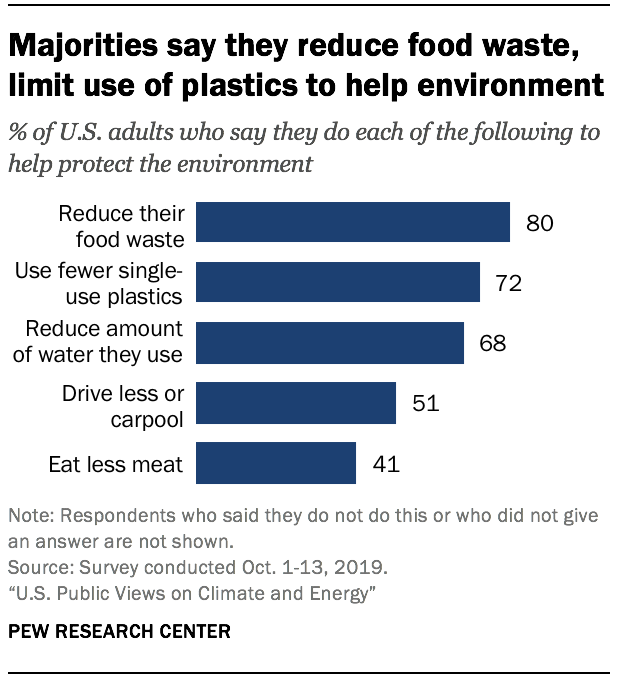
At a time when individuals are increasingly encouraged to help the environment through changes in everyday behaviors, most Americans say they are taking action, whether it’s reducing food waste or using fewer disposable plastics.
The survey asked respondents whether they engage in any of five specific actions in their everyday life for environmental reasons. Survey respondents also rated the efficacy of each of these five actions when it comes to helping the environment. (Half of the respondents, selected at random, were asked about their potential actions and half were asked about the efficacy of each action.)
Eight-in-ten Americans (80%) report that they reduce their food waste for environmental reasons. Large shares of the public (72%) say they use fewer plastics that cannot be reused such as plastic bags, straws, cups or reduce their water consumption (68%) to help the environment.
About half (51%) of Americans say they are driving less or using carpools, while about four-in-ten (41%) say they are eating less meat for environmental reasons.
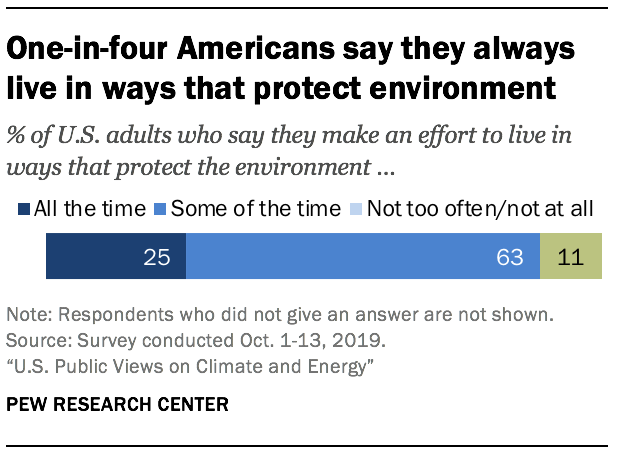
On average, people report doing 3.1 of these actions in their everyday lives. About a fifth of Americans (19%) report doing all five activities.
When assessing their overall behavior, one-quarter of U.S. adults (25%) say they make an effort to live in ways that help protect the environment “all the time,” up modestly from 20% in 2016. Another 63% report they live in environmentally conscious ways some of the time. Just 11% say they do not try at all to live in environmentally conscious ways or do so not too often.
Baby Boomer and older Americans are more likely than Millennial and Gen Z adults to report that they try to live in environmentally conscious ways all the time (32% vs. 18%, respectively).
When Americans think about the impact of five types of individual actions, two-thirds (67%) say that using fewer single-use plastics makes a big difference in helping protect the environment. About half of Americans say the same about reducing use of personal vehicles (52%), food waste (52%) or water use (50%). About a quarter of U.S. adults (24%) say that eating less meat makes a big difference for the environment, while 38% say this makes a small difference and another 38% think this makes almost no difference for the environment.
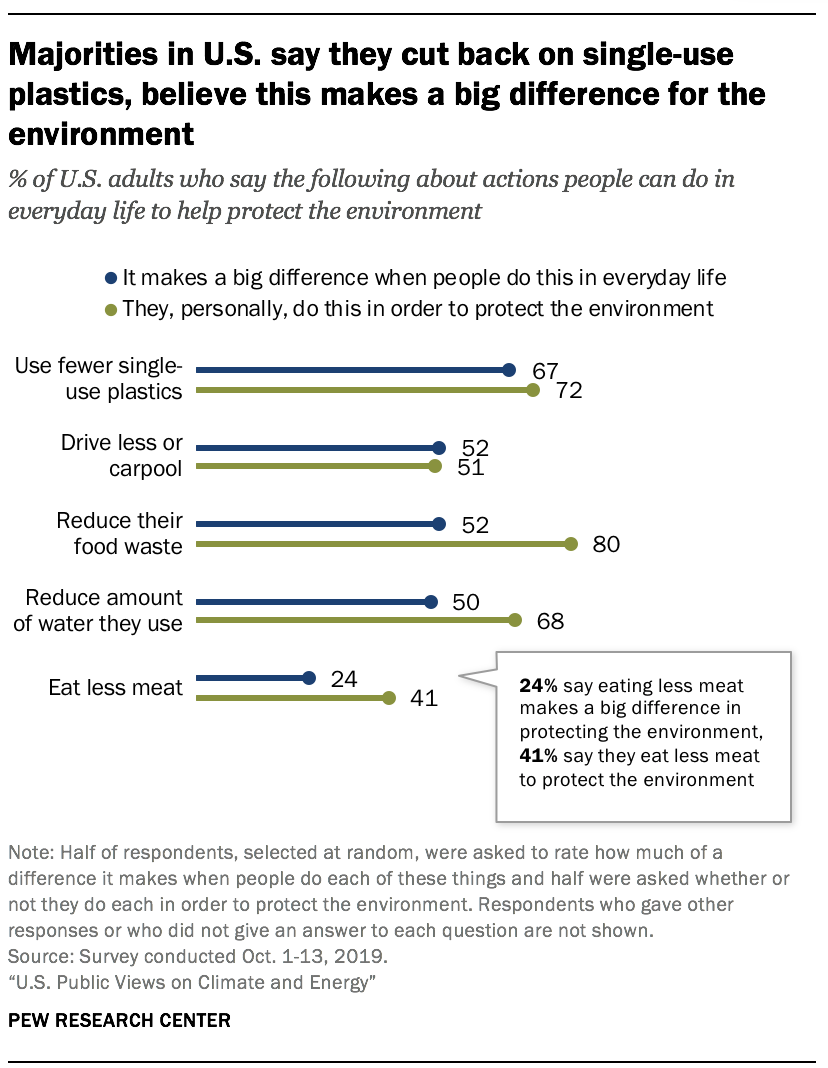
Public opinion about how they can protect the environment sometimes aligns with people’s actions, but not always.
For instance, about the same percentage of Americans who say using fewer single-use plastics makes a big difference for the environment (67%) report using fewer plastics in their daily lives (72%).
But in another example, while four-in-ten Americans (41%) say they eat less meat for environmental reasons, only a quarter (24%) believe doing so makes a big difference to the environment.
The quarter of Americans who say they always try to live in environmentally conscious ways are particularly likely to take these five specific actions to protect the environment.
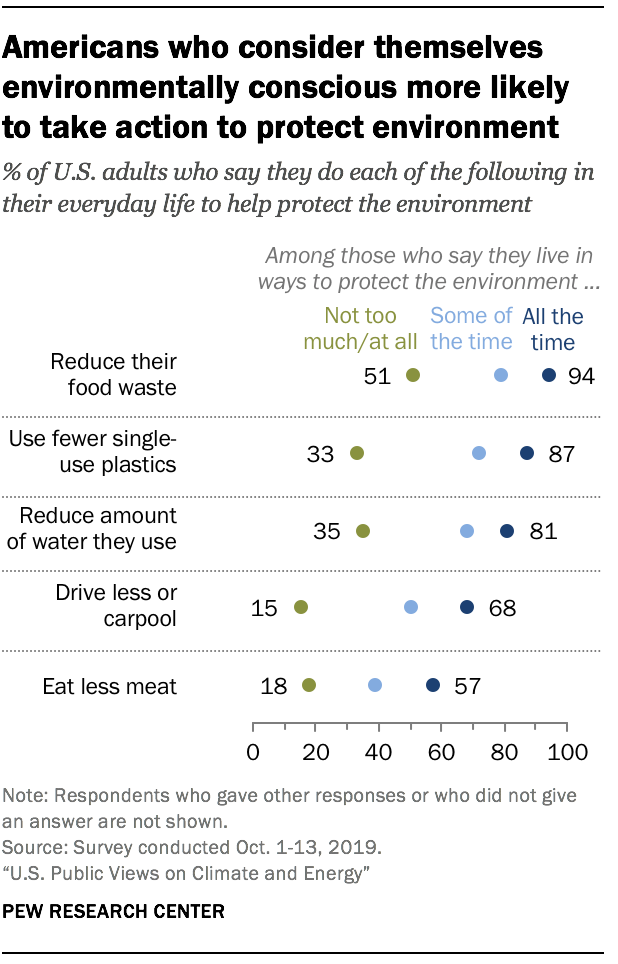
Most people in this group say they reduce their food waste (94%), use of disposable plastics (87%) or water consumption (81%) in efforts to help the environment. A smaller majority (68%) say they drive less or are eating less meat (57%) to benefit the environment.
Altogether, those who see themselves as environmentally conscious perform an average of 3.9 of these actions in their everyday lives, and more than one-third (37%) take all five actions.
This stands in contrast to the small percentage of Americans (11%) who describe themselves as doing either nothing or not too much to live in ways that protect the environment. Among this group, about half (51%) say they reduce their food waste. Fewer than half are using fewer disposable plastics (33%) or reducing their water use (35%), while even fewer are driving less (15%) or eating less meat (18%) for environmental reasons. On average, this group does 1.5 actions to help the environment and just 3% perform all five.
Gender and political affiliations are associated to some extent with whether Americans are changing their daily behaviors for the sake of the environment.
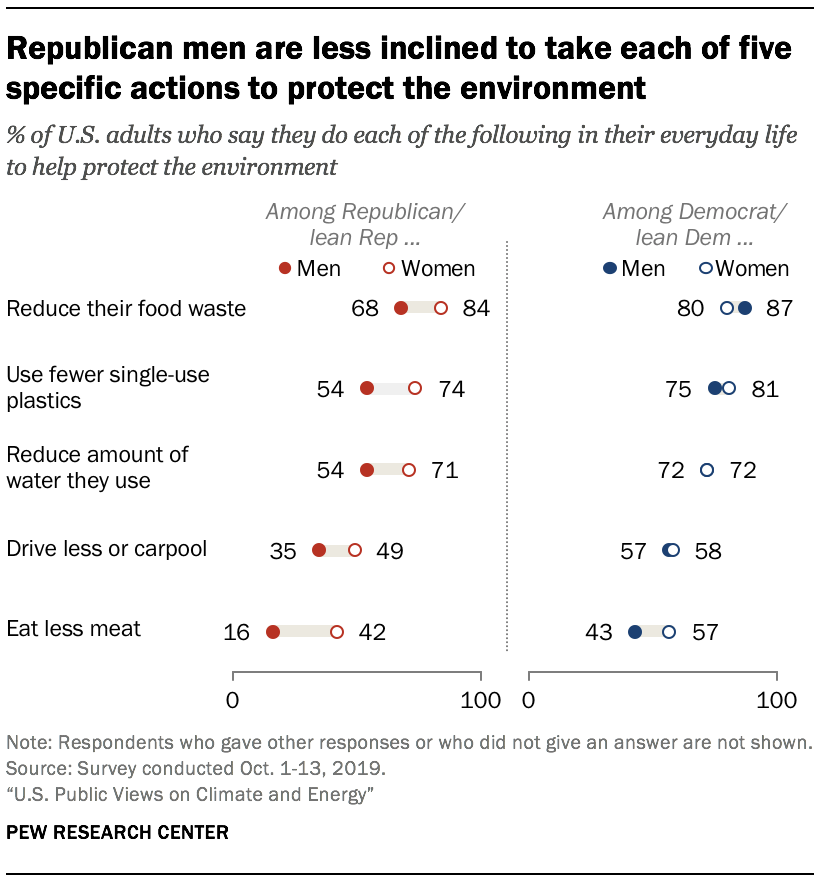
Republican men stand out as less likely to say they are changing their behaviors in any of the five ways included in the survey, from reducing food waste to eating less meat.
On the other hand, Republican and Democratic women as well as Democratic men are about equally likely to make these efforts to protect the environment, overall.
For example, 54% of Republican men report using fewer single-use plastics for environmental reasons, compared with roughly three-quarters or more of Republican women (74%), Democratic men (75%) and Democratic women (81%). (These figures include Republican- and Democratic-leaning independents.)
A relatively small percentage of Republican men (16%) say they eat less meat in an effort to help the environment, compared with about two and half times as many Republican women (42%). A more modest gender gap exists among Democrats, with closer percentages of men (43%) and women (57%) saying they eat less meat for environmental reasons.
Most Americans favor expanding renewable energy sources, but divides remain over expanding offshore drilling, nuclear power
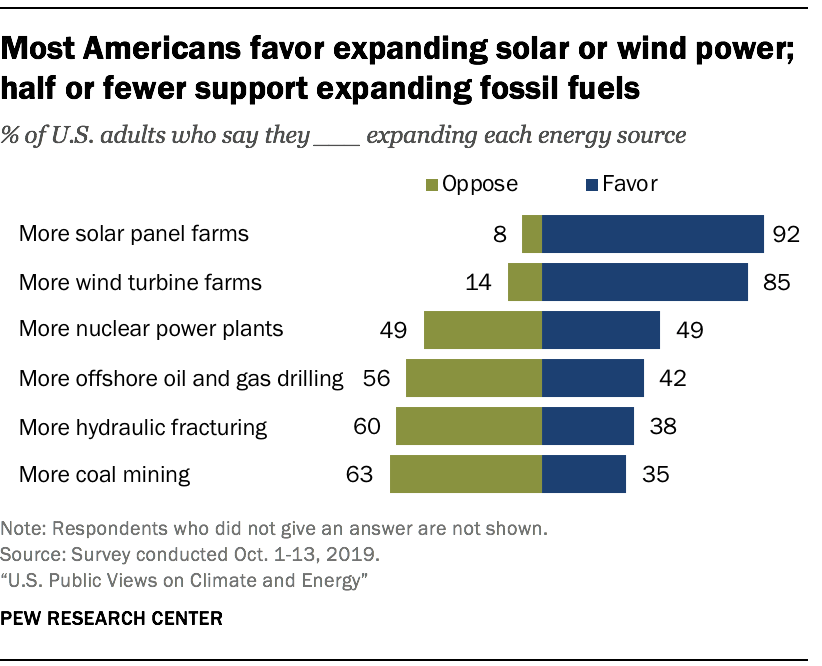
Most Americans favor expanding solar power (92%) or wind power (85%), including strong majorities of both Republicans and Democrats. The public, however, is evenly divided over whether to expand nuclear power (49% on each side). Fewer than half of Americans support more offshore oil and gas drilling (42%), hydraulic fracturing for oil and natural gas, known as “fracking” (38%) or coal mining (35%).
These findings are broadly in line with previous Center surveys, which found strong majorities in favor of increasing solar or wind power and more mixed views about expanding other energy sources. Support for more nuclear power plants has inched up 6 percentage points since 2016 (from 43% to 49% today). Support for coal mining has declined from 41% to 35% in the same period.
Sizable majorities of both Republicans and Democrats – including those who lean to each party – favor more solar panel farms (86% and 96%, respectively) or wind turbine farms (77% and 92%). More Republicans (59%) than Democrats (41%) support expanding nuclear power plants; support for nuclear power is stronger among conservative Republicans (63%) than among moderate or liberal Republicans (51%).
Long-standing political and ideological divides remain over support for expanding fossil fuel energy sources, including offshore oil drilling, hydraulic fracturing and coal mining. Majorities of Republicans favor expanding these sources, while most Democrats remain opposed. Though, there are some differences within each party. Three-quarters of conservative Republicans (76%) favor expanding offshore oil and gas drilling, as do about half of moderate or liberal Republicans (53%). In contrast, about three-in-ten moderate or conservative Democrats (28%) and just 12% of liberal Democrats support more offshore drilling.
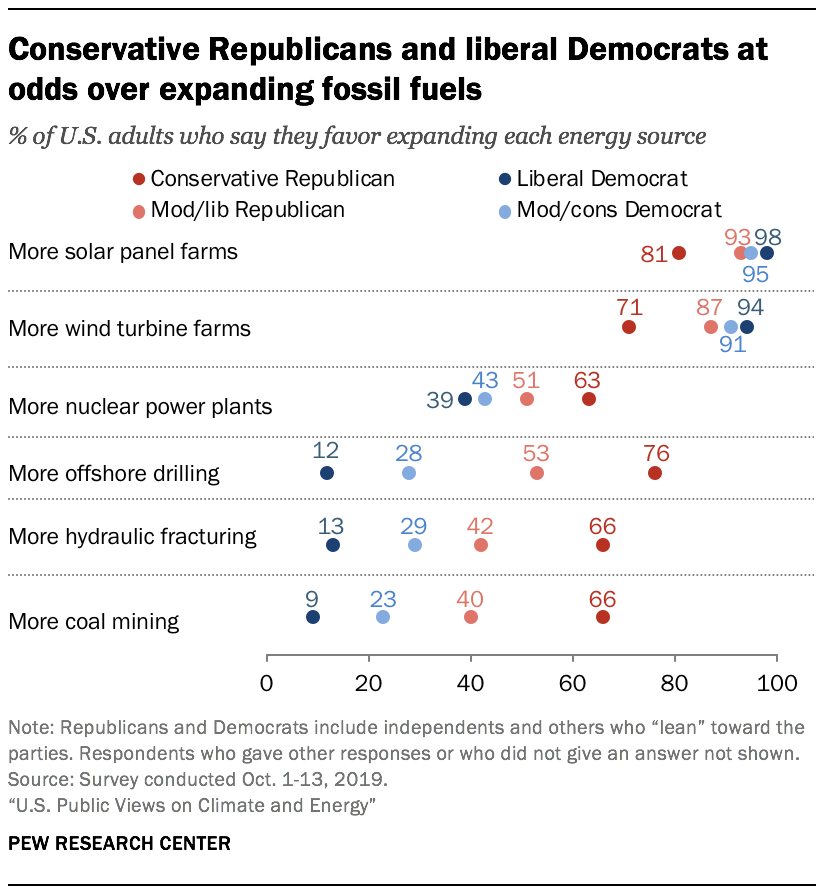
Conservative Republicans also stand out as more inclined to support expansion of hydraulic fracturing for oil and gas as well as coal mining (66% for each). By comparison, fewer than half of moderate or liberal Republicans favor expanding these energy sources (42% and 40% for hydraulic fracturing and coal mining, respectively).
Democrats are largely opposed to expanding either source. For example, a small fraction of liberal Democrats (9%) and about a quarter (23%) of moderate or conservative Democrats favor more coal mining. Support for offshore drilling and for hydraulic fracturing has declined among Democrats in recent years. (Support for coal mining has gone down among both parties since 2016. See the Appendix for details.)
While Democratic views about these energy sources tend to be fairly consistent across generational and gender lines, Republican views are not. GOP Baby Boomer and older generations are more supportive of expanding offshore drilling, coal mining and hydraulic fracturing than are Millennial and Gen Z Republicans. In addition, Republican men are more likely to favor expanding fossil fuel energy sources, especially hydraulic fracturing, than women who identify with or lean toward the GOP. (See the Appendix for details.)




